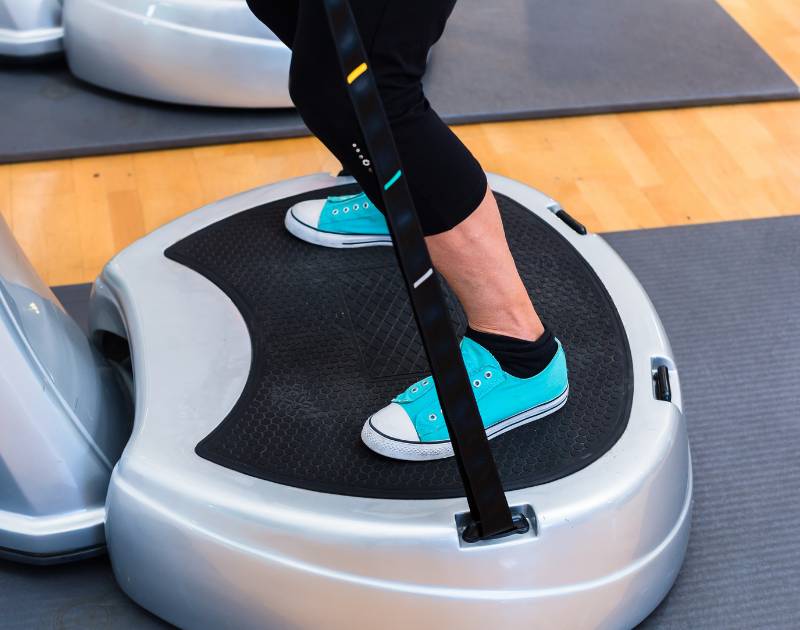Vibration Plates for Lymphedema Management: An Evidence‑Based Guide
Lymphedema—whether primary or secondary—involves impaired lymphatic drainage, leading to excess tissue fluid and chronic swelling. Standard care includes manual lymphatic drainage (MLD) and compression therapy.
Vibration plates (Whole Body Vibration, WBV) are emerging as a complementary tool to potentially support lymph flow and reduce discomfort. This medical guide—aligned with British Lymphology Society principles—covers compatibility, mechanisms, protocols, integration with compression, safety considerations, and progress monitoring.
1. Lymphedema Types and Vibration Therapy Compatibility
Primary lymphedema is a congenital or idiopathic impairment of lymphatics (e.g. Milroy disease). Secondary lymphedema arises from surgery, radiation, infection, or trauma—most commonly post‑mastectomy lymphedema.
WBV is most appropriate for Stage I–II lymphedema when tissue remains soft and responsive. It’s an adjunct—not a replacement—for MLD or compression, to be used under specialist guidance.
2. How Vibration Enhances Lymphatic Circulation
WBV delivers gentle mechanical forces that:
- Stretch skin and soft tissue, reducing interstitial pressure and facilitating fluid movement
- Stimulate lymphatic capillaries and collectors, enhancing uptake and flow
- Induce microvascular vasodilation, supporting lymph absorption and drainage
- Provide a low-effort “pump” effect especially helpful when manual methods are limited
These mechanisms support lymphatic drainage whole body vibration as a gentle complement to standard care, particularly when incorporated into a tailored vibration plate workout for beginners to ensure safe and effective use.
3. Scientific Evidence for WBV in Lymphedema
Though larger trials are limited, existing vibration plate research studies provide promising data:
- A pilot crossover in women with breast‑cancer related lymphedema found adding vibration to Self‑MLD within Complete Decongestive Therapy reduced limb volume more than MLD alone
- In chair-bound elderly adults, daily horizontal vibration (47 Hz) over two weeks significantly prevented progression of leg swelling, reducing pitting edema versus control
- Deep oscillation (resonance vibration) applied to Stage II lymphedema yielded reductions in swelling and discomfort, comparable to MLD alone and suggesting tissue softening and edema absorption effects
- Research using multidirectional vibrations (~30 Hz) showed improved skin blood flow and superficial lymphatic mobilization in early trials
Together, these findings align with the British Lymphology Society emphasis on activity and tissue mobilization as cornerstones of lymphedema care.
4. Specific Protocols by Affected Area
Arm (e.g. post‑mastectomy lymphedema)
- Position: seated; arm supported so hand/forearm rests lightly on plate
- Frequency: 20–30 Hz
- Amplitude: minimal (≈1–2 mm)
- Duration: 30–60 sec per set; 1–3 sets per session
- Best used just before MLD or compression sleeve application
Leg (leg lymphedema)
- Position: seated or supine; plate beneath feet or calves; trunk supported
- Frequency: 25–35 Hz
- Amplitude: ≤ 2 mm
- Duration: total of up to 3 minutes per session; 1–3 sessions per day
- Ideal when used between compression garment phases
Trunk (truncal lymphedema)
- Position: supine on horizontal vibration surface beneath back/pelvis
- Frequency: about 30 Hz in 1–2 minute bursts
- Suitable when targeting soft-tissue mobilization toward central lymph nodes
5. Combining WBV with Compression Garments
- Perform WBV prior to applying compression to soften tissue for better sleeve or stocking fit
- Avoid wearing tight compression during vibration use unless clearance allows slight looseness
- Post-WBV, apply compression immediately to redirect fluid moved by vibration
- WBV should supplement—not replace—Manual Lymphatic Drainage (MLD) sessions
6. Frequency and Positioning for Optimal Drainage
Evidence indicates:
- Frequencies of 20–35 Hz effectively support microcirculation and lymph mobilization without overstimulation
- Frequencies above 40 Hz may cause discomfort or blunt lymphatic function
- Vertical oscillation plates under foot are effective for limb drainage while seated or supine
- Horizontal or multidirectional vibration platforms are better suited for trunk applications
7. Precautions and Contraindications
Before using WBV:
- Ensure there is no active infection (e.g. cellulitis), thrombosis, untreated malignancy or acute inflammation
- Avoid WBV over fractured bone, recent surgery sites, or ports without clinical clearance
- Begin at low frequency, minimal amplitude and brief duration; monitor for increased swelling, heaviness or discomfort
- Discontinue immediately if symptoms worsen or skin integrity issues arise
- Contraindicated in uncontrolled cardiovascular conditions, pregnancy, or in individuals with certain vascular disorders unless cleared medically
8. Progress Monitoring Techniques
Track progress using:
- Limb volume measurements: circumferential tape or water displacement before and after WBV
- Pitting edema scoring: especially in lower limb cases to monitor changes in fluid retention
- Subjective logs: feelings of heaviness, tightness or relief on numerical scales
- Periodic photos of swelling areas and skin texture
- Feedback during or after therapy sessions from your lymphedema-trained therapist on integration of WBV with MLD/compression
Expect modest, gradual changes. WBV is more about maintaining mobility and preventing progression rather than curing lymphedema.
Alignment with British Lymphology Society Guidelines
The British Lymphology Society underscores that physical activity is a key pillar of lymphedema management, adaptable for all stages. While WBV is not yet a formal part of NICE or BLS protocols, its principles—tissue mobilization, circulation enhancement, and activity modulation—are consistent with recommended practice.
Physicians and therapists are encouraged to individualise use as part of Complex Decongestive Therapy (CDT) frameworks.
Final Thoughts
Lymphedema vibration plate therapy UK remains in early stages of clinical validation, but physiologic rationale and emerging studies suggest WBV may augment lymphatic drainage, reduce tissue stiffness, and support fluid mobilization when used carefully. Key recommendations:
- Use low frequency (20–35 Hz) and minimal amplitude, with seated or supine positioning ( see our vibration frequency guide here)
- Combine with compression and MLD, not as a standalone treatment
- Ensure regular monitoring and realistic expectations—improvements tend to be gradual maintenance rather than reversal
- Follow contraindication guidelines rigorously and stop if symptoms worsen
If incorporated thoughtfully into a broader self-care and compression regimen, WBV can become a safe, home‑based adjunct for managing arm, leg or trunk lymphedema, particularly post-surgical swelling management and tissue mobilization.
Always consult your lymphedema therapist or medical provider before introducing vibration plate therapy. When guided properly, it may offer a gentle pathway to better lymphatic care and comfort.
